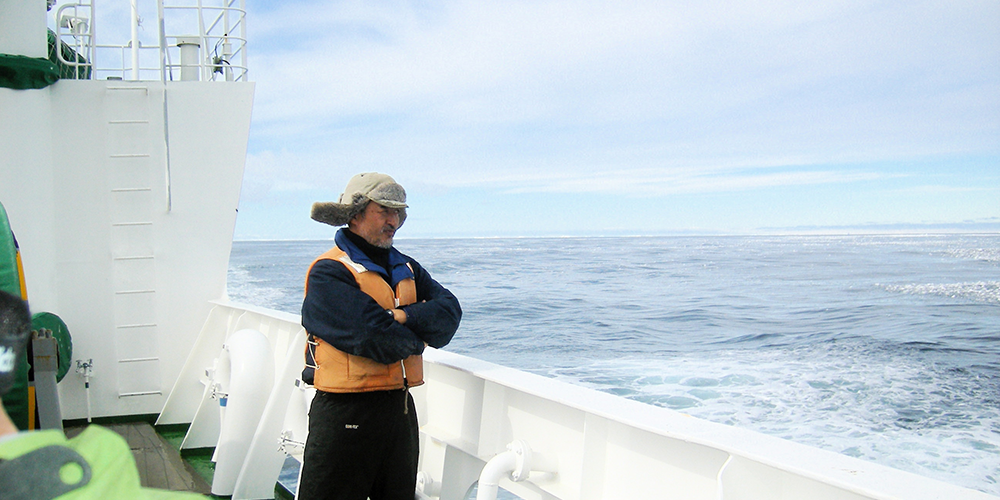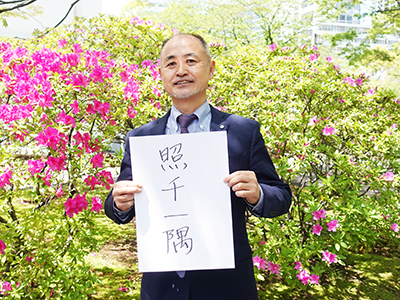People who convey voices from the sea
People who convey voices from the sea

A moment when plankton moves
New discoveries captured with a high-speed camera
Yuji Tanaka, former dean of the Faculty of Marine Resources and Environment
A moment when plankton moves
New discoveries captured with a high-speed camera
Yuji Tanaka, former dean of the Faculty of Marine Resources and Environment

Biography
Yuji Tanaka(Yuji Tanaka)
Faculty of Science Division of Marine Environmental Science Professor
After completing graduate school at Kyoto University, researcher at Hokkaido Wakkanai Fisheries Research Institute,
Faculty of Agriculture, Kindai University Assistant, Lecturer,
After working as a researcher at the Scripps Institute of Oceanography, University of California,
In 1998, he became an associate professor at the Faculty of Fisheries, Tokyo University of Fisheries (now Tokyo University of Marine Science and Technology).
Incumbent since 2013.
Since 2018, he has also served as Dean of the Faculty of Marine Resources and Environment.He is a doctor of agriculture.
- Q What kind of classes do you teach?
↓
- I am in charge of biological oceanography (Department of Marine Environmental Science, XNUMXnd year).Biological oceanography is oceanography that looks at the ocean from the perspective of "vessels in which organisms live."
The ocean is a vessel, or space, which occupies 5.1% of the earth's surface area of ??71 million km? and is enormous, with an average depth of about 4 meters, but it is also finite.What kind of creatures live where and how many in this sea, what they eat, what they are eaten by, how they grow, survive, multiply their offspring, and how they circulate matter.The sea creatures that serve as our food can change the sea environment, and when the sea environment changes, the sea creatures are also affected.What is the mechanism?What role do each of the organisms that live in the sea play in the ecosystem?Furthermore, how should we assess the impact of human activities on ecosystems and how should we tackle environmental conservation in the sea?I give lectures on what is necessary for students to learn about the "sea as a vessel for life" and to think about what is necessary for the sustainable prosperity of humankind.

Talking about plankton alongside a killer whale skeletal specimen - Q What kind of research are you doing?
↓
- I mainly study plankton*XNUMX.I am researching how organisms called plankton swim, what and how they eat, what and how they are eaten, and how they leave offspring.We also go offshore on a boat and measure where and how much plankton there is.
In particular, we are focusing on research that investigates the movement of plankton using a high-speed camera*2.Because plankton are small, you need a magnifying device such as a microscope to observe them.Although plankton are said to have a weak swimming ability, they actually move quite fast.The field of view of a microscope and the range in which it can be focused are narrow, aren't they?If you can swim smoothly, you can not observe it.Therefore, plankton are attached to the tip of the hair with instant adhesive, supported by a fine movement device called a micromanipulator, and photographed with a microscope or a high-speed camera equipped with a special magnifying lens.Hair is used because it is somewhat soft and harmless.A high-speed camera is used because a normal video camera can only shoot 1 frames per second, which means it cannot capture what is happening in less than 30/1th of a second.For example, plankton's legs move 30 round trips per second, so 1 frames per second won't tell us anything.
It's really strange to actually see plankton.There are also strange creatures that look like space creatures that appear in special effects.It's tiny, but it's scary when you magnify it with a microscope.Also, there are some that move more brilliantly and powerfully than you can imagine.For example, some athletes can travel hundreds of times their body length in one second.It is the ultimate form and technique that plankton acquired in the process of long evolution.I find it really interesting, and I'm investigating in detail how it works, how each part of the body works, and so on.Research may lead to the development of small robots that imitate the movements of plankton, such as those that can move freely inside blood vessels.
In fact, there are many things that plankton does not understand.Research on fast movements was only possible with a special device called a high-speed camera.From now on, new discoveries and research will be carried out one after another as technology advances.
*1 Plankton: Floating organisms.Generic name for organisms that are weak in swimming ability and drift in the water.
*2 High-speed camera: A high-speed camera.It shoots more strokes per second (frame rate: FPS) than a typical video camera.In the professor's research, shooting is performed at a maximum of 1 FPS.

Daphnia (about 2 mm long).
Left: It is fixed to the tip of the hair with instant glue and is held in water.In this state, they eat food and molt.
Right: It absorbs water containing many particles of food from the upper right, catches the particles with its fast-moving legs (densely covered with stinging hairs), and discharges water without particles from the bottom. - Q What kind of existence are plankton in the marine ecosystem?
↓
- Plants produce organic matter on land and in the sea.On land, trees, grasses, and moss absorb sunlight and carry out photosynthesis, but in the sea, algae, seaweed, and phytoplankton play a role in photosynthesis.
Since algae and seaweeds stick to the bottom of the sea and can only grow in shallow coastal waters, phytoplankton floating in the water is an important source of organic matter in most of the open sea.In order to float (not sink), it must be small in size.Phytoplankton are 1 ?m (0.001 mm) to at most 1 mm.There are actually a lot of small ones like this, and they carry out photosynthesis while drifting in a layer where sunlight can reach to some extent (up to about 100 m in the open ocean).Zooplankton of 1 mm or at most a few centimeters eat it, grow and multiply.They are eaten by carnivorous zooplankton and small fish, then by large fish, and finally by humans.In this way, the marine ecosystem starts with phytoplankton and connects to fish through zooplankton, and plankton greatly affects the amount of fish available to us.In other words, plankton are extremely important organisms that form the basis of marine ecosystems, including humans.
But they never live for humans.In order to live and leave descendants, we have evolved over millions, tens of millions, and billions of years, and as a result, we are on the present earth.When I face such plankton, I can't help but mutter, "Please tell us how well you who have lived on the earth are doing."

Take the interview seriously. - Q What is your favorite plankton?
↓
- Nothing in particular.There is a wide variety of plankton, and the appearance, shape, and way of life are different for everyone.There is no such thing as one species being important and the other being unimportant for each species.If I were XNUMX people, I would study XNUMX kinds of plankton.Any kind of plankton loses track of time when facing it.

State of the experiment. October 2010.At the Ocean Research Institute of the University of Tokyo in Otsuchi, Iwate Prefecture.
Photographing the movement of plankton with a graduate student using a high-speed camera. - Q What made you decide to become a researcher?
↓
- I have been familiar with the sea since I was a child.Also, every week I was engrossed in watching a TV program showing mysterious and beautiful underwater images.That must have been what sparked his interest in the sea.
After that, while reading, watching, and listening to various things, I decided that I wanted to study the ocean in relation to food resources and environmental conservation, and entered the Department of Fisheries at Kyoto University.However, when I was an undergraduate, I was a bad student who was immersed in sports and not enthusiastic about studying.At that time, a teacher who seemed to be enjoying his research took me to work in the fishing industry and on ships, which changed my life.I remember seeing the bluefin tuna farming site and being so moved that I shuddered and thought, "This is amazing!"So, in the middle of my fourth year, I remembered my original intention and decided to study fisheries, and entered graduate school.
In graduate school, I was a little discouraged, and the more I studied, the more I realized that in order to return science to society, for example, in order to contribute to environmental conservation, we must work on the basics. 40 years later, I still feel that way.
So, just as I was finishing my master's course, I happened to get a job at the Fisheries Resources Department of the Hokkaido Fisheries Research Institute, which was the beginning of my life as a researcher.

When I was a novice researcher. May 1985.On the deck of the Hokkaido Wakkanai Fisheries Research Institute.
The stern is a Danish seine otter board. - Q: Looking ahead to 2030, what kind of research would you like to do with incoming students?
↓
- In fact, I will be past the retirement age and will not be at Ocean University by the time all of you who will be entering the university become graduate students.What I can do in the short time from now on is to pass on my knowledge and experience through classes, experiments, and practical training.I would like all of you to understand the peculiarities of the ocean and make the most of it.Ocean University has an irreplaceable strength of having a training ship.
I want you to leave it to your interest and challenge various things.It is also a good idea to collect plankton by boat and grow it.Taking care of living things is hard work, but it's fun.It would be a good idea to work on it without looking away in order to capture the decisive moment of plankton in your graduation thesis.Rest assured that even if you fail, your life will not be taken.If you succeed, you may make a big discovery.Regardless of success or failure, I am lucky if I come across a problem that I can immerse myself in.
The technology that can be used for research is becoming new every day.For example, in the past, plankton was first examined by getting on a boat and catching it with a net, but there are many things that lose their shape when caught with a net.Research on these fragile plankton is slow to progress, but a new method of photographing and recording directly in the sea may lead to groundbreaking progress.I believe that humankind should put in as much effort into developing such technology as it does in space development.It may be interesting for people interested in physics and engineering, as well as those interested in biology, to develop equipment and robots for plankton research.Diversity is important.I want diverse students to find what they are good at among various subjects.We, faculty members, teach students how fun (and difficult) study and research can be, and help them find what they are good at.

2nd year "Marine Environmental Science Practicum". July 2007, in a classroom onboard the Seitaka Maru.
He teaches students to analyze seawater taken from deep sea.Intensive training is carried out by staying overnight on the ship. - Q What would you say to the younger generation who are about to enter university?
↓
- Health comes first!It's a species that lives.Everyone is important.Same as plankton.It is a miracle that we are still alive after such a long period of time.Please cherish the miraculous time.

Antarctic Dawn. January 2010.On the deck of the Umitaka Maru.With the students of the major course.







